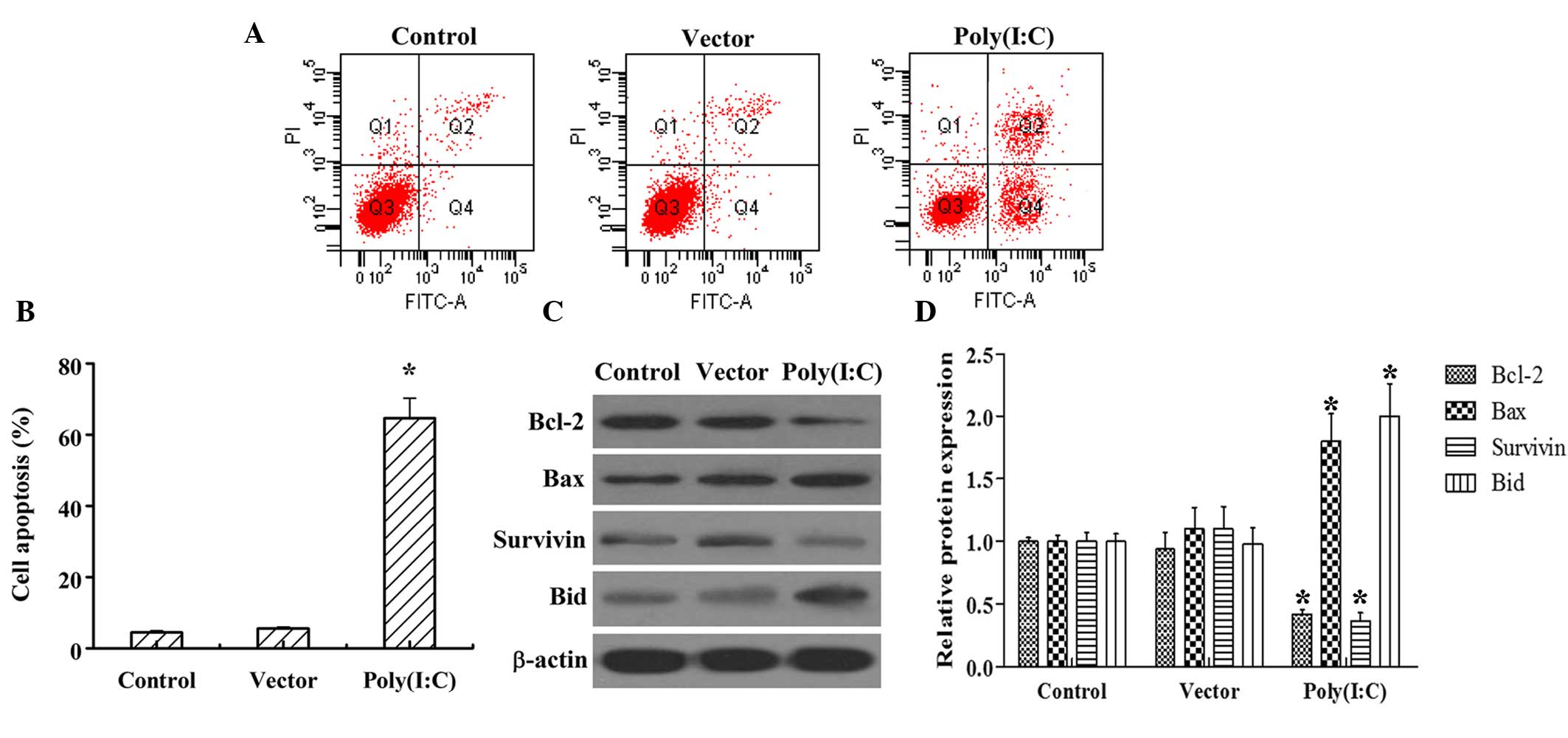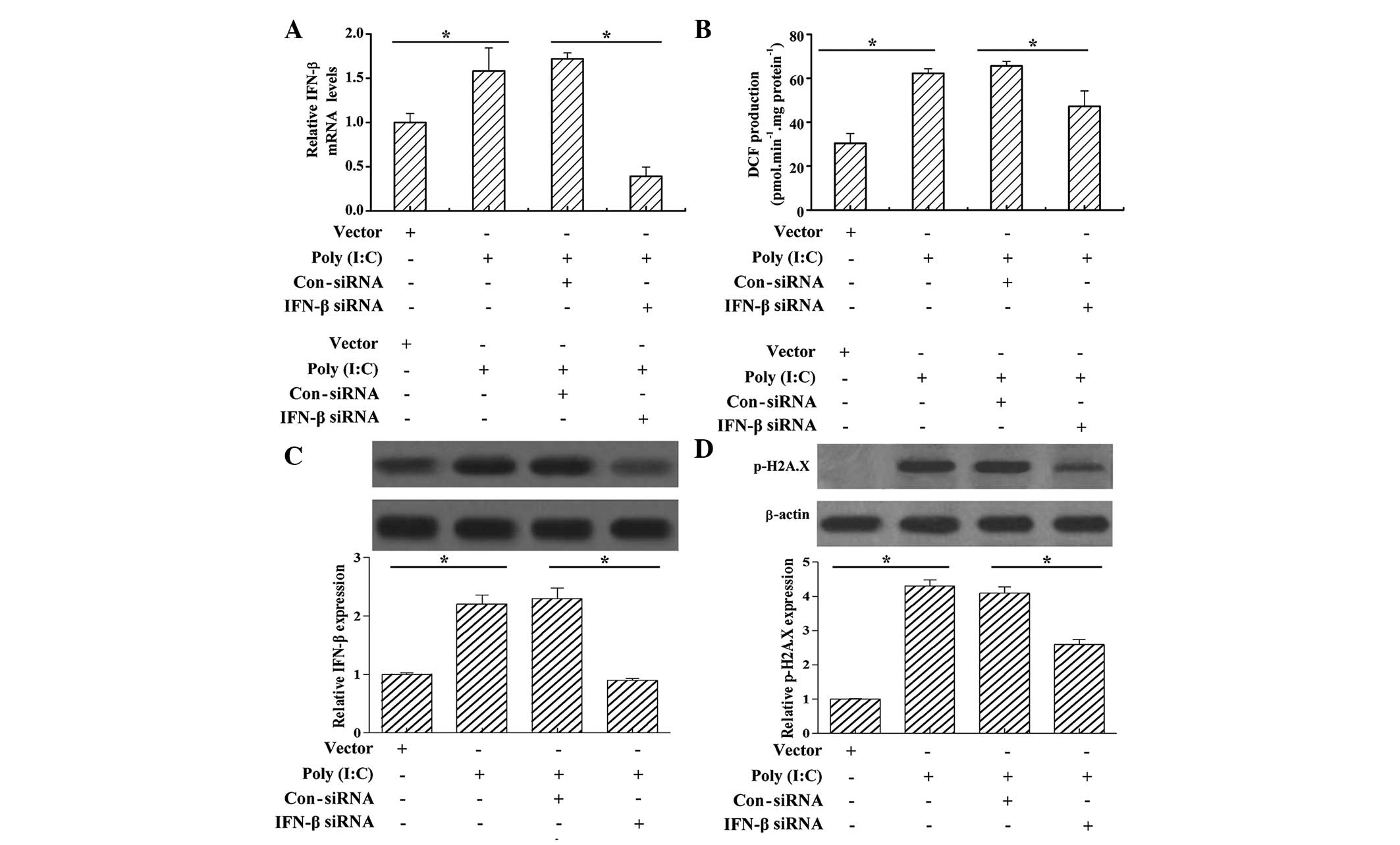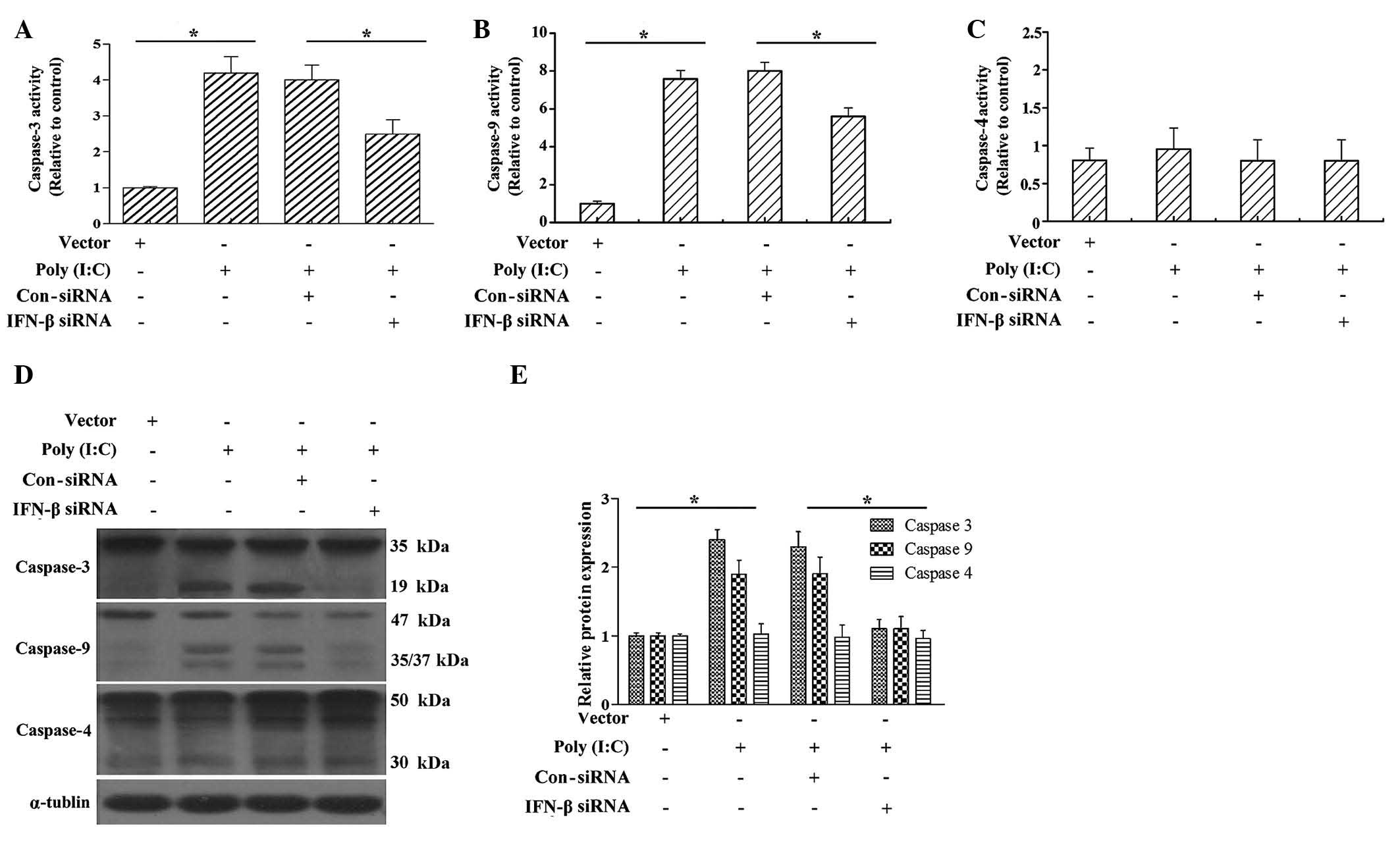|
1
|
Einstein MH, Schiller JT, Viscidi RP,
Strickler HD, Coursaget P, Tan T, Halsey N and Jenkins D:
Clinician's guide to human papillomavirus immunology: Knowns and
unknowns. Lancet Infect Dis. 9:347–356. 2009. View Article : Google Scholar : PubMed/NCBI
|
|
2
|
Chauhan SC, Jaggi M, Bell MC, Verma M and
Kumar D: Epidemiology of human papilloma virus (hpv) in cervical
mucosa. Methods Mol Biol. 471:439–456. 2009. View Article : Google Scholar
|
|
3
|
Ashkenazi A and Dixit VM: Death receptors:
signaling and modulation. Science. 281:1305–1308. 1998. View Article : Google Scholar : PubMed/NCBI
|
|
4
|
Li P, Nijhawan D, Budihardjo I,
Srinivasula SM, Ahmad M, Alnemri ES and Wang X: Cytochrome c and
dATP-dependent formation of Apaf-1/caspase-9 complex initiates an
apoptotic protease cascade. Cell. 91:479–489. 1997. View Article : Google Scholar : PubMed/NCBI
|
|
5
|
Ma Y, Zhang J, Zhang Q, Chen P, Song J, Yu
S, Liu H, Liu F, Song C, Yang D and Liu J: Adenosine induces
apoptosis in human liver cancer cells through ROS production and
mitochondrial dysfunction. Biochem Biophys Res Commun. 448:8–14.
2014. View Article : Google Scholar : PubMed/NCBI
|
|
6
|
Tait SW and Green DR: Mitochondria and
cell death: Outer membrane permeabilization and beyond. Nat Rev Mol
Cell Bio. 11:621–632. 2010. View
Article : Google Scholar
|
|
7
|
Li H, Zhu H, Xu CJ and Yuan J: Cleavage of
BID by caspase 8 mediates the mitochondrial damage in the Fas
pathway of apoptosis. Cell. 94:491–501. 1998. View Article : Google Scholar : PubMed/NCBI
|
|
8
|
Singh KK: Mitochondria damage checkpoint,
aging and cancer. Ann NY Acad Sci. 1067:182–190. 2006. View Article : Google Scholar
|
|
9
|
Fujimura T, Nakagawa S, Ohtani T, Ito Y
and Aiba S: Inhibitory effect of the polyinosinic-polycytidylic
acid/cationic liposome on the progression of murine B16F10
melanoma. Eur J Immunol. 36:3371–3380. 2006. View Article : Google Scholar : PubMed/NCBI
|
|
10
|
Zhang Y, Lin A, Sui Q, Zhang C, Tian Z and
Zhang J: Phosphorothioate modification of the TLR9 ligand CpG ODN
inhibits poly (I:C)-induced apoptosis of hepatocellular carcinoma
by entry blockade. Cancer Lett. 355:76–84. 2014. View Article : Google Scholar : PubMed/NCBI
|
|
11
|
Peng S, Geng J, Sun R, Tian Z and Wei H:
Polyinosinic-pol ycytidylic acid liposome induces human hepatoma
cells apoptosis which correlates to the up-regulation of RIG-I like
receptors. Cancer Sci. 100:529–536. 2009. View Article : Google Scholar : PubMed/NCBI
|
|
12
|
Sottini A, Capra R, Serana F, Chiarini M,
Caimi L and Imberti L: Interferon-beta therapy monitoring in
multiple sclerosis patients. Endocr Metab Immune Disord Drug
Targets. 9:14–28. 2009. View Article : Google Scholar : PubMed/NCBI
|
|
13
|
Cha L, de Jong E, French MA and Fernandez
S: IFN-α exerts opposing effects on activation-induced and
IL-17-induced proliferation of T cells that may impair homeostatic
maintenance of CD4+ T cell numbers in treated HIV
infection. J Immunol. 193:2178–2186. 2014. View Article : Google Scholar : PubMed/NCBI
|
|
14
|
Hong B, Li H, Lu Y, Zhang M, Zheng Y, Qian
J and Yi Q: USP18 is crucial for IFN-γ-mediated inhibition of B16
melanoma tumorigenesis and antitumor immunity. Mol Cancer.
13:1322014. View Article : Google Scholar
|
|
15
|
Ryu H, Oh JE, Rhee KJ, Baik SK, Kim J,
Kang SJ, Sohn JH, Choi E, Shin HC and Kim YM: Adipose
tissue-derived mesenchymal stem cells cultured at high density
express IFN-β and suppress the growth of MCF-7 human breast cancer
cells. Cancer Lett. 352:220–227. 2014. View Article : Google Scholar : PubMed/NCBI
|
|
16
|
Matsuzuka T, Miller K, Pickel L, Doi C,
Ayuzawa R and Tamura M: The synergistic induction of
cyclooxygenase-2 in lung fibroblasts by angiotensin II and
pro-inflammatory cytokines. Mol Cell Biochem. 320:163–171. 2009.
View Article : Google Scholar
|
|
17
|
Takano S, Ishikawa E, Matsuda M, Yamamoto
T and Matsumura A: Interferon-β inhibits glioma angiogenesis
through downregulation of vascular endothelial growth factor and
upregulation of interferon inducible protein 10. Int J Oncol.
45:1837–1846. 2014.PubMed/NCBI
|
|
18
|
Jablonska J, Leschner S, Westphal K,
Lienenklaus S and Weiss S: Neutrophils responsive to endogenous
IFN-beta regulate tumor angiogenesis and growth in a mouse tumor
model. J Clin Invest. 120:1151–1164. 2010. View Article : Google Scholar : PubMed/NCBI
|
|
19
|
Harashima N, Minami T, Uemura H and Harada
M: Transfection of poly (I:C) can induce reactive oxygen
species-triggered apoptosis and interferon-β-mediated growth arrest
in human renal cell carcinoma cells via innate adjuvant receptors
and the 2–5A system. Mol Cancer. 13:2172014. View Article : Google Scholar
|
|
20
|
Siegal FP, Kadowaki N, Shodell M,
Fitzgerald-Bocarsly PA, Shah K, Ho S, Antonenko S and Liu YJ: The
nature of the principal type 1 interferon-producing cells in human
blood. Science. 284:1835–1837. 1999. View Article : Google Scholar : PubMed/NCBI
|
|
21
|
Livak KJ and Schmittgen TD: Analysis of
relative gene expression data using real-time quantitative PCR and
the 2(-Delta Delta C(T)) Method. Methods. 25:402–408. 2001.
View Article : Google Scholar
|
|
22
|
Laggner H, Hermann M, Gmeiner BM and
Kapiotis S: Cu2+ and Cu+ bathocuproine
disulfonate complexes promote the oxidation of the ROS-detecting
compound dichlorofluorescin (DCFH). Anal Biochem Chem. 385:959–961.
2006. View Article : Google Scholar
|
|
23
|
Yim HY, Yang Y, Lim JS, Lee MS, Zhang DE
and Kim KI: The mitochondrial pathway and reactive oxygen species
are critical contributors to interferon-α/β-mediated apoptosis in
Ubp43-deficient hematopoietic cells. Biochem Biophys Res Commun.
423:436–440. 2012. View Article : Google Scholar : PubMed/NCBI
|
|
24
|
Rottenberg H and Wu S: Quantitative assay
by flow cytometry of the mitochondrial membrane potential in intact
cells. Biochim Biophys Acta. 1404:393–404. 1998. View Article : Google Scholar : PubMed/NCBI
|
|
25
|
Liu Y, Zhang SP and Cai YQ: Cytoprotective
effects of selenium on cadmium-induced LLC-PK1 cells apoptosis by
activating JNK pathway. Toxicol In Vitro. 21:677–684. 2007.
View Article : Google Scholar : PubMed/NCBI
|
|
26
|
Chawla-Sarkar M, Leaman DW and Borden EC:
Preferential induction of apoptosis by interferon (IFN)-beta
compared with IFN-alpha2: Correlation with TRAIL/Apo2 L induction
in melanoma cell lines. Clin Cancer Res. 7:1821–1831.
2001.PubMed/NCBI
|
|
27
|
Pelicano H, Carney D and Huang P: ROS
stress in cancer cells and therapeutic implications. Drug Resist
Update. 7:97–110. 2004. View Article : Google Scholar
|
|
28
|
Hensley K, Robinson KA, Gabbita SP,
Salsman S and Floyd RA: Reactive oxygen species, cell signaling and
cell injury. Free Radical Bio Med. 28:1456–1462. 2000. View Article : Google Scholar
|
|
29
|
Gillies LA and Kuwana T: Apoptosis
regulation at the mitochondrial outer membrane. J Cell Biochem.
115:632–640. 2014. View Article : Google Scholar : PubMed/NCBI
|
|
30
|
Li C, Wei J, Li Y, He X, Zhou Q, Yan J,
Zhang J, Liu Y, Liu Y and Shu HB: Transmembrane Protein 214
(TMEM214) mediates endoplasmic reticulum stress-induced caspase 4
enzyme activation and apoptosis. J Biol Chem. 288:17908–17917.
2013. View Article : Google Scholar : PubMed/NCBI
|
|
31
|
Pimm MV and Baldwin RW: Treatment of
transplanted rat tumours with double-stranded RNA (BRL 5907). II
Treatment of pleural and peritoneal growths. Br J Cancer.
33:166–171. 1976. View Article : Google Scholar : PubMed/NCBI
|
|
32
|
Pimm MV, Embleton MJ and Baldwin RW:
Treatment of transplanted rat tumours with double-stranded RNA (BRL
5907). I Influenced of systemic and local administration. Br J
Cancer. 33:154–165. 1976. View Article : Google Scholar : PubMed/NCBI
|
|
33
|
Adams JM and Cory S: The Bcl-2 apoptotic
switch in cancer development and therapy. Oncogene. 26:1324–1337.
2007. View Article : Google Scholar : PubMed/NCBI
|
|
34
|
Kang BH, Xia F, Pop R, Dohi T, Socolovsky
M and Altieri DC: Developmental control of apoptosis by the
immunophilin aryl hydrocarbon receptor-interacting protein (aip)
involves mitochondrial import of the survivin protein. J Biol Chem.
286:16758–16767. 2011. View Article : Google Scholar : PubMed/NCBI
|
|
35
|
Croker BA, O'Donnell JA, Nowell CJ,
Metcalf D, Dewson G, Campbell KJ, Rogers KL, Hu Y, Smyth GK, Zhang
JG, et al: Fas-mediated neutrophil apoptosis is accelerated by Bid,
Bak and Bax and inhibited by Bcl-2 and Mcl-1. Proc Natl Acad Sci
USA. 108:13135–13140. 2011. View Article : Google Scholar
|
|
36
|
Kang J and Pervaiz S: Mitochondria: Redox
metabolism and dysfunction. Biochem Res Int. 2012:8967512012.
View Article : Google Scholar : PubMed/NCBI
|
|
37
|
Yoboue ED and Devin A: Reactive oxygen
species-mediated control of mitochondrial biogenesis. Int J Cell
Biol. 2012:4038702012. View Article : Google Scholar : PubMed/NCBI
|
|
38
|
Yadav N and Chandra D: Mitochondrial and
postmitochondrial survival signaling in cancer. Mitochondrion.
16:18–25. 2014. View Article : Google Scholar
|



















